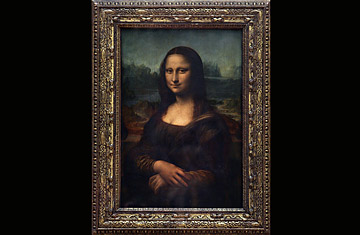
Leonardo da Vinci's Mona Lisa
The beauty of Mona Lisa comes as much from what the subject is hiding as what she reveals. Who is she looking at? What triggered that famous smile? Is she even smiling at all?
Art historians have deduced in that singularly mysterious visage everything from a cross-dressing self-portrait of Leonardo da Vinci to the knowing glance of an unfaithful wife to the satisfied pride of a pregnant woman. Bob Dylan once even offered up a very 20th century American conclusion on the matter: "Mona Lisa must've had the highway blues."
A Sicilian professor of pathological anatomy has come up with the latest and what is probably the least poetic explanation imaginable for why the woman looks the way she does: high cholesterol. Vito Franco of the University of Palermo has spent his spare time applying his medical expertise to the study of famous subjects of Renaissance artworks. And in the first formal collection of his findings, Franco has concluded that the woman whom Italians call "La Gioconda" suffered from xanthelasma, the accumulation of cholesterol just under the skin. Franco told the newspaper La Stampa this week that he spotted clear signs of the condition around Mona Lisa's left eye as well as evidence of a lipoma, a fatty-tissue tumor, on her right hand. Hardly a flattering diagnosis for one of history's most enchanting beauties.
But Franco, who presented his findings at a European congress on human pathology in Florence last fall, says his objective is not to bleed the lyricism out of art but rather to render the lives of the subjects more vivid. "Illness is part of the body, not a metaphysic or supernatural dimension," Franco told La Stampa. "And so in revealing their physicality, the people depicted expose their human vulnerability independently from our awareness of the authors of the work."
Among the some 100 works he has studied, which include Egyptian sculptures and contemporary paintings, Franco is particularly fond of exploring those that depict ailments during the Renaissance. Among his conclusions: the Spanish child Margarita, in Diego Velázquez's Las Meninas, likely suffered from both a thyroid condition known as goiter and the genetic disorder linked to premature puberty, McCune-Albright syndrome. The unusually long, thin fingers of the young nobleman in Sandro Botticelli's Portrait of a Young Man, which is displayed at the National Gallery in Washington, indicates that the subject suffered from Marfan syndrome, a genetic disorder of the connective tissue. The professor even performed a checkup on the master of the masters, Michelangelo, who is depicted in the foreground of Raphael's The School of Athens with swollen knees, which Franco says were likely caused by kidney stones.
Luisa Dolza, a Paris-based historian of science, doesn't see much new ground being broken by Franco, in either the study of art or medicine. Still, she acknowledges that the project is useful for making the public aware of what was happening during the Renaissance, when the great minds threw themselves into different fields in the pursuit of truth and beauty. "Something new was happening then, where if the wife of the emperor was ugly, she was depicted as ugly. This was no Photoshop," says Dolza, an expert in Renaissance-era technology. "These painters, Leonardo and Michelangelo, studied anatomy and illnesses. They loved to represent humans with all their faults."
As for Mona Lisa, that enigmatic face will keep prompting new theories from its admirers. Over the past decade, American neurological researchers have suggested that her seemingly disappearing smile is an effect caused by the way the brain processes certain elements of light. There is another possibility that may be hard to disprove: La Gioconda's face is itself a mirror on which the story of our own lives is reflected. Does it make you smile? Sort of.
